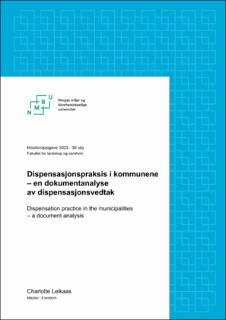| dc.contributor.advisor | Fredrik Holth | |
| dc.contributor.author | Leikaas, Charlotte | |
| dc.date.accessioned | 2023-07-15T16:27:51Z | |
| dc.date.available | 2023-07-15T16:27:51Z | |
| dc.date.issued | 2023 | |
| dc.identifier | no.nmbu:wiseflow:6839533:54591860 | |
| dc.identifier.uri | https://hdl.handle.net/11250/3079302 | |
| dc.description.abstract | SAMMENDRAG
Kommunen skal styre over arealene som ligger innenfor kommunens administrative områder, og plan skal være styringsverktøyet. Gjennom plan- og bygningslovens (pbl.) bestemmelser kan kommunen foreta allsidige og langsiktige vurderinger for den optimale arealbruken (Winge: 2013). Noen ganger kan det være nødvendig å fravike bestemmelser gitt i, eller i medhold av plan- og bygningsloven. Dispensasjonsadgangen følger av plan- og bygningsloven § 19-2, og gir kommunene anledning til å dispensere fra aktuelle lovbestemmelser, tilhørende forskrifter og planer. Dispensasjonsbestemmelsen er en unntaksbestemmelse, og til tross for at lovgivers intensjon er at utvikling skal skje gjennom plan, innvilges det et stort antall dispensasjoner i landets kommuner.
Begrepet «med dispensasjonspraksis skal landet bygges», er i mange tilfeller dessverre en beskrivelse av kommunenes bruk av dispensasjoner. Det er denne problematikken denne masteroppgaven vil belyse. For at kommunen skal kunne ha anledning til å gi dispensasjon følger det av pbl. § 19-2 andre ledd to kumulative vilkår som må være oppfylt for at dispensasjon skal kunne innvilges: vesentlighetsvilkåret og fordel-/ulempevilkåret.
Det er blitt gjort en innsamling av dispensasjonsvedtak, og utført en dokumentanalyse av fire utvalgte case-kommuner: Råde, Moss, Hol og Hemsedal. Til sammen er det analysert 464 dispensasjonsvedtak. Ulike parametere er ført i tabell, og presenteres i ulike diagrammer. Et utvalg av åtte dispensasjonsvedtak har blitt undersøkt nærmere. Innvilgelsesprosenten var sprikende hos de utvalgte kommunene, og flertallet av dispensasjonene ble innvilget.
Tidligere undersøkelser og denne analysen viser at det er utfordringer knyttet til kommunenes liberale dispensasjonspraksis og at innvilgelsesprosenten for dispensasjoner er høy. I utgangspunktet bør lovtolkning skje ut fra en standardisert metode. Dette er for å sikre en dispensasjonspraksis som gir mest mulig like resultater uavhengig av hvilken kommune som tolker loven. Likevel er det stor variasjon i kommunene på hvordan bestemmelsen blir praktisert. Majoriteten av vedtakene er ikke tilstrekkelig begrunnet, og kommunene overholder ikke begrunnelsesplikten i henhold til forvaltningsloven (fvl.) §§ 24 og 25.
Dispensasjonsbestemmelsen har også en grensedragning mellom juss og politikk. Dispensasjonsmyndigheten til politikerne blir ofte misforstått, slik at dispensasjoner innvilges på feilaktig grunnlag. Politisk behandling av dispensasjoner er med på å uthule planer som skal ligge til grunn for arealforvaltningen.
I oppgaven blir det også løftet frem noen teorier om hvorfor så mange dispensasjoner blir innvilget. I konklusjonen reflekteres det rundt mulige ulike tiltak som kan gjennomføres for å sikre at dispensasjonspraksisen i kommunene blir mer i tråd med lovgivers intensjon. | |
| dc.description.abstract | ABSTRACT
The municipality must manage the areas that lie within the municipality's administrative areas, and the plan must be the management tool. Through the provisions of the Planning and Building Act, the municipality can make versatile and long-term assessments for the optimal use of land (Winge: 2013). Sometimes it may be necessary to deviate from provisions given in, or pursuant to, the Planning and Building Act. The dispensation access follows from § 19-2 of the Planning and Building Act, and gives the municipalities the opportunity to dispensate from relevant legal provisions, associated regulations and plans. Dispensation is an exception provision, and despite the fact that the legislator's intention is for development to take place through planning, a large number of exemptions are granted in the country's municipalities.
The term "with dispensation practice the country will be built", is unfortunately in many cases a description of the municipalities' use of dispensations. It is this problem that this master's thesis will shed light on. In order for the municipality to have the opportunity to grant a dispensation, it follows from pbl. § 19-2 second paragraph two cumulative conditions that must be met for a dispensation to be granted: the materiality requirement and the advantage/disadvantage condition. A collection of dispensation decisions has been made, and a document analysis of four selected case municipalities has been carried out: Råde, Moss, Hol and Hemsedal. A total of 464 dispensation decisions have been analysed. Different parameters are tabulated and presented in different diagrams. A selection of eight dispensation decisions has been examined in more detail. The approval percentage varied among the selected municipalities, and the majority of dispensations were granted. Previous investigations and this analysis show that there are challenges linked to the municipalities' liberal dispensation practice and that the approval percentage for dispensations is high. In principle, legal interpretation should be based on a standardized method. This is to ensure a dispensation practice that gives the most equal results, regardless of which municipality interprets the law. Nevertheless, there is great variation in the municipalities on how the provision is put into practice. The majority of the decisions are not sufficiently reasoned, and the municipalities do not comply with the duty to provide reasons in accordance with §§ 24 and 25 of the Public Administration Act.
The dispensation provision also draws a line between law and politics. The dispensation authority of the politicians is often misunderstood, so that dispensations are granted on the wrong basis. Political treatment of dispensations helps to erode plans that are to be the basis for land management. In the thesis, some theories are also put forward as to why so many dispensations are granted. The conclusion reflects on possible different measures that can be implemented to ensure that the dispensation practice in the municipalities is more in line with the legislator's intention. | |
| dc.language | nob | |
| dc.publisher | Norwegian University of Life Sciences | |
| dc.title | Dispensasjonspraksis i kommunene - en dokumentanalyse av dispensasjonsvedtak | |
| dc.type | Master thesis | |
